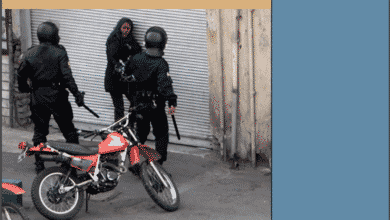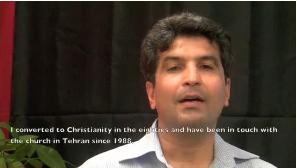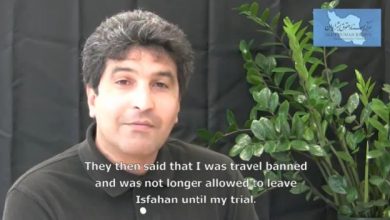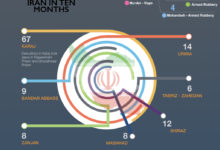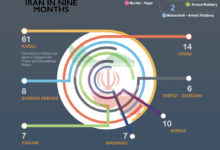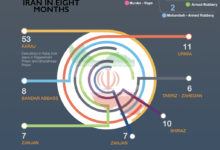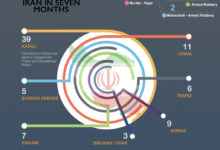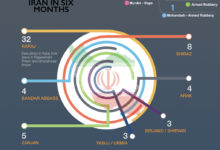Fundamentals of Freedom of Movement in Iran
 Introduction to Freedom of Movement
Introduction to Freedom of Movement
Freedom of Movement is an important tenet of liberty and a human right protected by Article 12 of the International Covenant on Civil and Political Rights (ICCPR).
 Examples of Freedom of Movement Barriers in Iran
Examples of Freedom of Movement Barriers in Iran
Many Iranians are banned from traveling outside Iran, and also from traveling within the state.
 Documenting Human Rights in Iran: Evidence Collection Guide
Documenting Human Rights in Iran: Evidence Collection Guide
This guide includes information regarding how to spot violations of freedom of movement, and collect evidence of the violation.
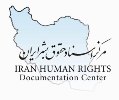 IHRDC Urges Iran to Release Opposition Leaders
IHRDC Urges Iran to Release Opposition Leaders
The house-arrests of political leaders Mir Hussain Mousavi and Mehdi Karoubi illustrates a common way in which the Iranian government restricts freedom of movement.
 Witness Statement: Ensafali Hedayat
Witness Statement: Ensafali Hedayat
Activist Ensafali Hedayat was beaten by government agents, and threatened with severe punishments if he failed to leave Tabriz within six months.
 Witness Statement: Soraya
Witness Statement: Soraya
Interrogators accused “Soraya” of espionage and treason resulting from a trip taken to Turkey.
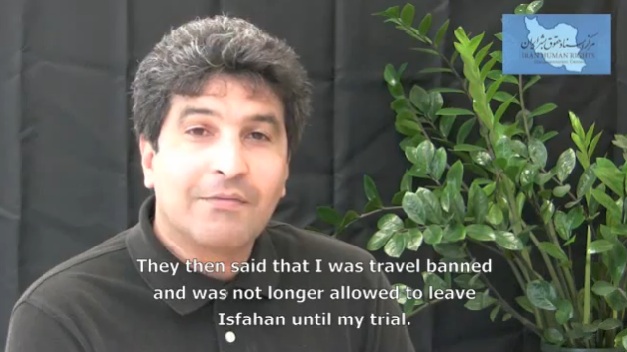 Witness Testimony: Morad Mohktari
Witness Testimony: Morad Mohktari
Morad Mokhtari, a convert from Islam to Christianity, testifies about the persecution he suffered in Iran after he converted, including restrictions on his ability to move within Iran, as well as his ability to leave the country.
 Witness Statement: Arash Sigarchi
Witness Statement: Arash Sigarchi
The Ministry of Intelligence ordered that Arash Sigarchi be exiled to southern Iran in order to limit his ability to flee the country.
Introduction to Freedom of Movement Violations in Iran:
Freedom of Movement is an important human right. The freedom to move within a state and the freedom to leave a state provides individuals with the ability to freely choose their place of residence, and to freely move from one place to another. Freedom of movement often serves as a last resort of protection for those suffering persecution. This right is set forth in article 12 of the International Covenant on Civil and Political Rights (ICCPR), which states that:
1. Everyone lawfully within the territory of a State shall, within that territory, have the right to liberty of movement and freedom to choose his residence.
2. Everyone shall be free to leave any country, including his own.
3. The above-mentioned rights shall not be subject to any restrictions except those which are provided by law, are necessary to protect national security, public order (ordre public), public health or morals or the rights and freedoms of others, and are consistent with the other rights recognized in the present Covenant.
4. No one shall be arbitrarily deprived of the right to enter his own country.
Paragraphs 5 and 7 of General Comment 27 to article 12 clarify the meaning of the word “State.” Paragraph 5 states that the “right to move freely relates to the whole territory of a State, including all parts of federal States.” It explains that “persons are entitled to move from one place to another and to establish themselves in a place of their choice. The enjoyment of this right must not be made dependent on any particular purpose or reason for the person wanting to move or to stay in a place.”
Paragraph 7 explains that an individual’s “right to reside in a place of one’s choice within the territory includes protection against all forms of forced internal displacement. It also precludes preventing the entry or stay of persons in a defined part of the territory.” This right is, however, limited by lawful detention of persons, as defined by article 9 of the ICCPR.
Article 33 of the Constitution of the Islamic Republic of Iran also protects freedom of movement, stipulating that “[n]o person may be ousted from his residence, or forbidden to reside in the locality of his choice, or compelled to reside in a particular locality, unless the law prescribes this.”
While both international and Iranian law protect the right to the freedom of movement, the Islamic Republic of Iran has placed severe restrictions on the freedom to move and live throughout the State, and on the freedom to leave the State. Examples of such restrictions include placing innocent individuals under house arrest, expelling individuals from cities who have done nothing wrong, discriminating against individuals with refugee status, and prohibiting individuals from leaving the state by means of detention or simple refusal to issue valid passports or accept valid visas. These restrictions violate the ICCPR, to which Iran is a signatory, and violate Iran’s Constitution.
Examples of Freedom of Movement Barriers in Iran
Unfounded Allegations in Leaving Iran
Iranian officials often accuse individuals of suspect behavior when they leave the state.
- In August 2009, the interrogators of a female detainee who wishes to remain anonymous accused her of espionage and treason resulting from her recent trip to Turkey. Her interrogators suggested that she was a spy, and involved in a group working against the Iranian government.[1]
- In October 2009, Mohammad-Reza Ali-Zamani, a 37-year-old Iranian, was sentenced to death in part for allegedly illegally exiting Iran.[2] He was executed in January 2010.
Freedom to Move and Live Throughout the State
Iran limits the freedom of movement within its borders of political activists and others it deems threats to the State party.
- In 2003, police and plainclothes agents beat journalist and human rights activist Ensafali Hedayat and threatened to cut off his testicles if he failed to leave Tabriz within six months.[3]
- In February 2005, the Ministry of Intelligence ordered that Arash Sigarchi be exiled to southern Iran to limit his ability to flee the country.[4]
- Following the June 2009 presidential election, a court sentenced Ahmad Zeidabadi, Secretary-General of Tahkim-e Vahdat (a student organization), to five years exile in a city in northeastern Iran.[5]
Iran also interferes with individuals’ freedom of movement by subjecting former detainees to frequent and arbitrary arrests, and requiring them to check in at a court or office.
- State party agents continued to harass and invade the privacy of women’s rights activist Mahboubeh Abbasgholizadeh after releasing her from custody in December 2009. Interrogators constantly called and threatened her, forcing her to take the SIM card out of her phone.[6]
- A few weeks after her arrest, beating, and release without being charged in January 2010, Tania Ahmadi Kaliji received a court summons to report to court.[7]
Freedom to Leave the State
Iran interferes with individuals’ freedom of movement by arbitrarily preventing them from leaving the State.
- On May 7, 2009, State party authorities prevented two prominent women’s rights activists from travelling to Guatemala, where they were scheduled to speak at a conference about the role of women in democracies. The women, Narges Mohammadi and Soraya Azizpanah, were stopped at Immam Khomeini Airport and ordered to report to Tehran’s Revolutionary Court within 72 hours. They were not given an explanation.[8]
- Four days after the June 12, 2009 election, Greek journalist Iason Athanasiadis was arrested and detained as he was leaving the country through Tehran’s airport.[9]
- Aida Sadaat, journalist and women’s rights activist, was prohibited from leaving Iran after signing an open letter in August 2009 criticizing the government’s reaction to post-election protests.[10]
- Zhina Modares Gorji, a women’s rights activist in Sanandaj, was on her way to Dubai on November 13, 2009 when she was stopped in the airport. She passed through the Passport Control Desk and received an exit stamp, but was paged over the airport speaker. A plainclothes agent confiscated her passport and ordered her to report to the Revolutionary Court in Sanandaj.[11]
- On March 8, 2010, authorities prevented Simin Behbahani, Iran’s national poet and veteran women’s rights activist, from leaving Imam Khomeini Airport and confiscated her passport. Commentators believe that Behbahani’s travel ban was in retaliation for comments she made to the international media shortly after Neda Agha-Soltan’s June 2009 death.[12]
- Mansoureh Behkish, a member of the Mothers for Peace and the Mourning Mothers, was prevented from traveling to Italy to visit her children on March 17, 2010. Passport agents confiscated her passport without explanation. The Mourning Mothers (Madaran-i Azadar) is a civil society group formed by mothers (and their supporters) who lost their children and spouses in state-sanctioned violence following Iran’s disputed June 2009 presidential election. The Mourning Mothers hold vigils for their loved ones.[13]
- In March 2010, the Iranian government banned former President Mohammad Khatami from leaving Iran to attend a nuclear disarmament conference.[14]
- In January 2011, authorities barred Mohammad Baqer Qalibaf, the Mayor of Tehran, from travelling to the United States to receive an award for advancing sustainable transportation in Tehran.[15]
- In July 2011, authorities again banned former President Mohammad Khatami from leaving Iran. He was scheduled to attend a political seminar in Ireland.[16]
[1] Witness Statement of Soraya [pseudonym] prepared by IHRDC and approved by witness (April 12, 2010), available athttps://www.iranhrdc.org/english/publications/witness-testimony/3182-witness-statement-soraya.html?p=4.
[2] IHRDC, Press Release: IHRDC Condemns the Death Sentence of Mohammad-Reza Ali-Zamani (Oct 9, 2009), available athttps://www.iranhrdc.org/english/news/press-statements/3133-ihrdc-condems-the-death-sentence-of-mohammad-reza-ali-zamani.html.
[3] Witness Statement of Ensafali Hedayat, prepared by IHRDC and approved by witness (Nov. 24, 2008) ¶ 21, available athttps://www.iranhrdc.org/english/publications/witness-testimony/3173-witness-statement-ensafali-hedayat.html?p=6.
[4] Witness Statement of Arash Sigarchi, prepared by IHRDC and approved by witness (Oct. 23, 2008) ¶ 54, available athttps://www.iranhrdc.org/english/publications/witness-testimony/3176-witness-statement-arash-sigarchi.html?p=17.
[5] IHRDC, Violent Aftermath: The 2009 Election and the Suppression of Dissent in Iran 87 (Feb. 2010), available athttps://www.iranhrdc.org/english/publications/reports/3161-violent-aftermath-the-2009-election-and-suppression-of-dissent-in-iran.html?p=8.
[14] Fars News Agency, Mohammad Khatami Mamnouolkhorouj Shodeh ast ]Mohammad Khatami Was Travel-Banned[ (Mar. 9, 2010) available athttp://www.farsnews.com/newstext.php?nn=8812181003.
[15] Fars News Agency, Mokhalefat-e Vezarat-e Eomour-e Kharej-e ba Safar-e Ghalibaf be Heiat-e Hamrah be Washington [Foreign Ministry’s Objection to Traveling of Ghalibaf and his Delegation to Washington] (Jan. 21, 2011) available at http://www.farsnews.net/newstext.php?nn=8911010331.
[16] Haaretz, Report: Former president Khatami barred from leaving Iran (July 26, 2011) available at http://www.haaretz.com/news/middle-east/report-former-president-khatami-barred-from-leaving-iran-1.375404.

